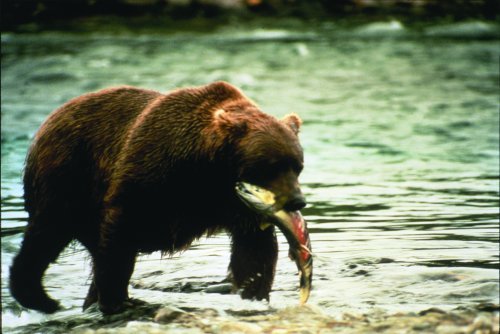
Alaska at the Omnimax
There are no penguins in Alaska. Oh, don't
be disappointed--there are tons of other cool (we should say cold) things
in the Land of the Midnight Sun--as you'll discover at the Rangos Omnimax
Theater's new
feature, Alaska: Spirit of the Wild, opening
October 1. For instance; did you know Alaska, the biggest state in the
union, covers four time zones and the state of Texas could fit in it twice
over? Produced by the people who created Africa: The Serengeti,
and narrated by Academy Award winner Charlton Heston, Alaska takes viewers
fishing with brown bears, soaring with bald eagles, swimming with salmon,
flying above Mt. McKinley, diving with humpback whales, dodging calving
glaciers, and racing with caribou. The state's rich history—including the
1897 Gold Rush, magnificent landscapes, harsh climate, and sense of adventure
are all here.
Making this movie was an adventure
itself. The aurora borealis sequence was shot in -100-degree temperatures
and all the equipment froze. Then a female polar bear tried to elude a
suitor by "joining" the crew! If you dread Pittsburgh winters, take
a trip to the Last Frontier. The 5,000 glaciers, the permafrost, and the
igloos make a Steel City winter look balmy.
Light Sculpture.
In July, the e-motion light sculpture should
be in place and working atop Carnegie Science Center's Omnimax dome. Created
from a tension-type fabric, the 80-foot parabolic torus-shaped (i.e. a
donut-shaped cone) sculpture should soon become a Pittsburgh landmark.
During the day, sunlight reflecting off the sculpture's surface will bounce
back onto the building, creating a continuous, ever-changing play of shadows
and color. At night, lights beneath the sculpture will create a halo effect
over the building and offer a light show of changing colors, sequences,
and effects. Stay tuned: plans are afoot to make the sculpture interactive--allowing
people to change the lighting sequences from kiosks on from the Science
Center property, Mt. Washington, or Point State Park.
Autumn Skies
Those of us who live in the northeast, must
contend with weather patterns that hide the sky from our view about two
thirds of the time! Such a lack of sunny skies and starry nights can be
an incredible challenge to the enthusiastic skywatcher. That’s why most
astronomers will seize every clear day and night to do some observing.
Making the most of what nature hands you
is key to enjoying backyard astronomy, so its important to be aware of
your best opportunities. And your best opportunities are here! You see,
the same weather patterns that confound our observing plans so often, tend
to work in our favor in September and October. One hundred and fifty years
of weather data has shown that throughout most of the eastern United States,
September and October have the clearest skies of the year. From Maine to
the deep south, a giant crescent of largely clear, steady skies tends to
make its appearance. Of course in predicting weather there are no guarantees,
but Pittsburghers tend to have the best skies of the year from mid September
until early November.
Clear, steady skies and cool evenings are
the perfect combination for taking in the beauty of the universe. But be
aware, the good skies will not last long. By early November, the skies
over western Pennsylvania begin to change dramatically as we enter some
of the cloudiest times of year. In November and December it’s not unusual
for thick clouds to blanket our sky for more than eighty percent of the
time!
The lesson of years past is clear, enjoy
as many clear nights under the stars as you can in the coming weeks. Join
us at the Science Center’s Buhl Observatory every clear Saturday night,
because autumn skies will soon give way to the clouds of winter!
--John G. Radzilowicz, Director Henry
Buhl, Jr. Planetarium & Observatory
|

